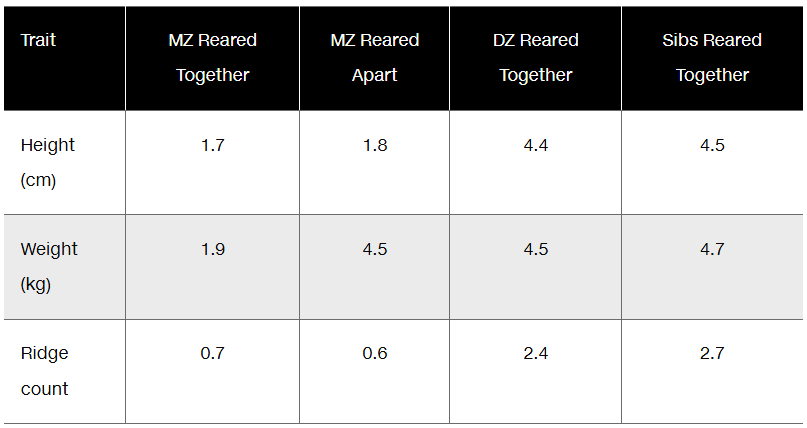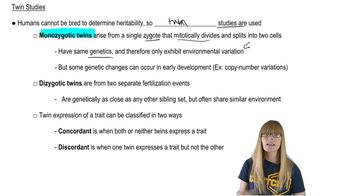How do we know that monozygotic twins are not identical genotypically as adults?
Table of contents
- 1. Introduction to Genetics51m
- 2. Mendel's Laws of Inheritance3h 37m
- 3. Extensions to Mendelian Inheritance2h 41m
- 4. Genetic Mapping and Linkage2h 28m
- 5. Genetics of Bacteria and Viruses1h 21m
- 6. Chromosomal Variation1h 48m
- 7. DNA and Chromosome Structure56m
- 8. DNA Replication1h 10m
- 9. Mitosis and Meiosis1h 34m
- 10. Transcription1h 0m
- 11. Translation58m
- 12. Gene Regulation in Prokaryotes1h 19m
- 13. Gene Regulation in Eukaryotes44m
- 14. Genetic Control of Development44m
- 15. Genomes and Genomics1h 50m
- 16. Transposable Elements47m
- 17. Mutation, Repair, and Recombination1h 6m
- 18. Molecular Genetic Tools19m
- 19. Cancer Genetics29m
- 20. Quantitative Genetics1h 26m
- 21. Population Genetics50m
- 22. Evolutionary Genetics29m
20. Quantitative Genetics
Heritability
Problem 8
Textbook Question
In the following table, average differences of height, weight, and fingerprint ridge count between monozygotic twins (reared together and apart), dizygotic twins, and nontwin siblings are compared:

Based on the data in this table, which of these quantitative traits has the highest heritability values?
 Verified step by step guidance
Verified step by step guidance1
Step 1: Understand the concept of heritability in this context. Heritability measures the proportion of phenotypic variation in a trait that is due to genetic differences among individuals. Lower average differences between genetically identical individuals (like monozygotic twins) compared to less genetically related individuals (like dizygotic twins or siblings) suggest higher heritability.
Step 2: Compare the average differences for each trait between monozygotic (MZ) twins reared together and apart, dizygotic (DZ) twins reared together, and siblings reared together. Smaller differences in MZ twins relative to DZ twins and siblings indicate stronger genetic influence.
Step 3: For each trait (height, weight, ridge count), observe the pattern of differences: the smaller the difference in MZ twins compared to DZ twins and siblings, the higher the heritability. For example, height shows very small differences in MZ twins (1.7 and 1.8) compared to larger differences in DZ twins (4.4) and siblings (4.5).
Step 4: Note that weight shows a larger difference in MZ twins reared apart (4.5) compared to reared together (1.9), which suggests environmental factors also play a role. Ridge count differences are generally smaller but the difference between MZ and DZ twins is less pronounced.
Step 5: Conclude which trait has the highest heritability by identifying the trait with the greatest difference between MZ twins and DZ twins/siblings, indicating the strongest genetic influence.
 Verified video answer for a similar problem:
Verified video answer for a similar problem:This video solution was recommended by our tutors as helpful for the problem above
Video duration:
1mPlay a video:
Was this helpful?
Key Concepts
Here are the essential concepts you must grasp in order to answer the question correctly.
Heritability
Heritability measures the proportion of observed variation in a trait among individuals that can be attributed to genetic differences. It ranges from 0 to 1, where higher values indicate a stronger genetic influence. Heritability is often estimated by comparing trait similarities between relatives with different genetic relatedness.
Recommended video:
Guided course

Calculating Heritability
Twin Studies
Twin studies compare monozygotic (MZ) twins, who share nearly 100% of their genes, with dizygotic (DZ) twins, who share about 50%. Differences in trait similarity between these groups help estimate genetic and environmental contributions. MZ twins reared apart provide insight into genetic effects independent of shared environment.
Recommended video:
Guided course

Twin Studies
Quantitative Traits and Environmental Influence
Quantitative traits, like height, weight, and fingerprint ridge count, vary continuously and are influenced by multiple genes and environmental factors. Comparing trait differences among relatives reared together or apart helps distinguish genetic effects from environmental ones, clarifying the trait's heritability.
Recommended video:
Guided course

Traits and Variance

 7:04m
7:04mWatch next
Master Calculating Heritability with a bite sized video explanation from Kylia
Start learningRelated Videos
Related Practice
Textbook Question
463
views
